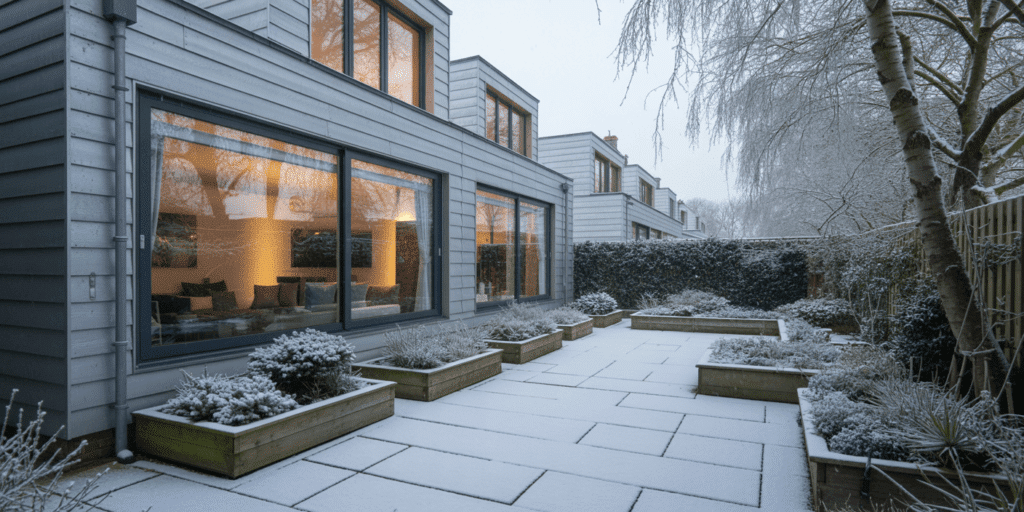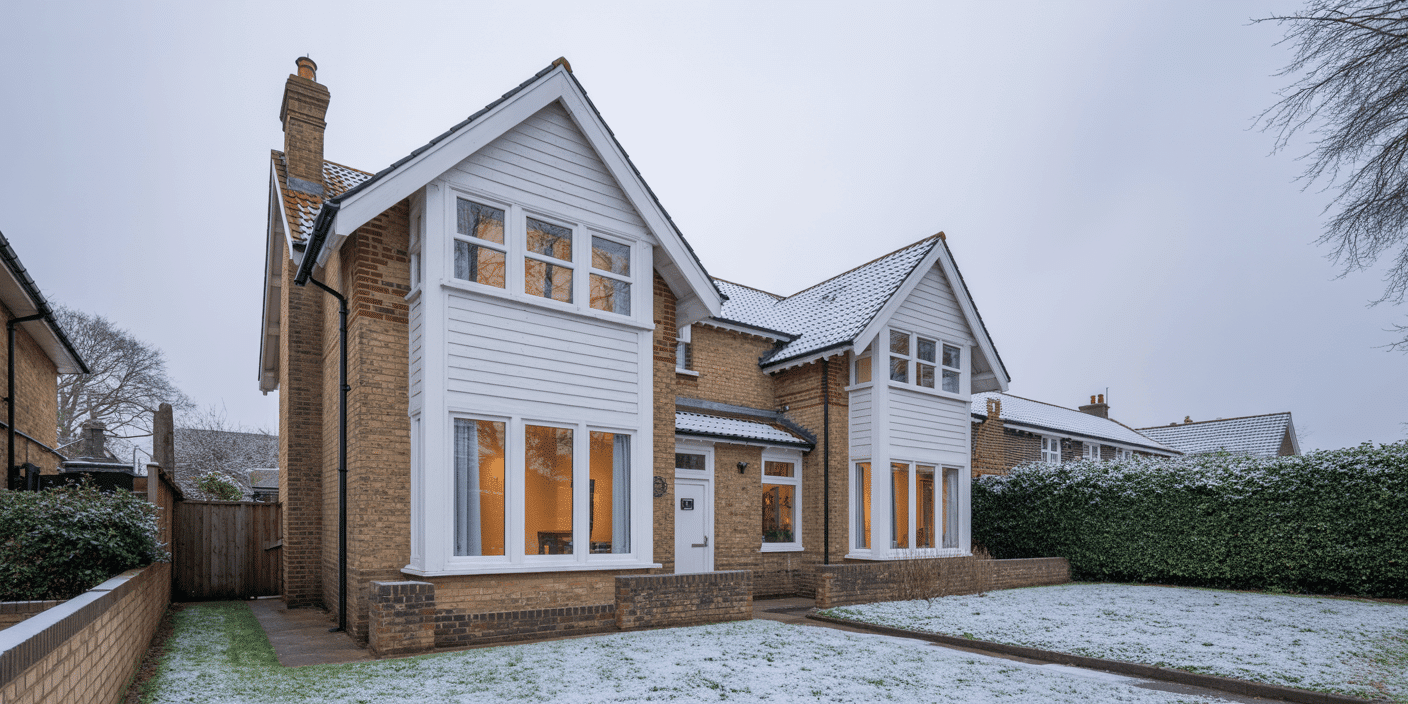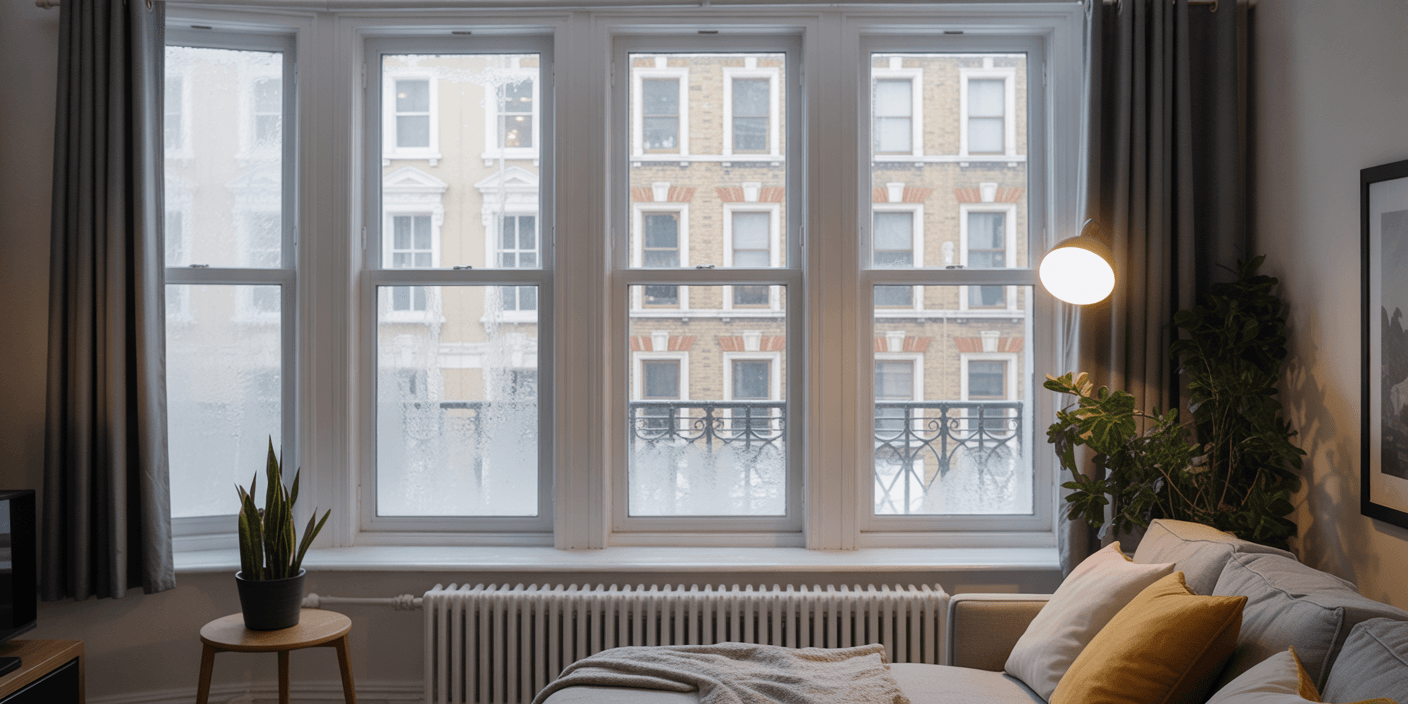Why Frame Material Matters More Than Most Realise
When discussions turn to energy-efficient windows, attention typically falls on the glazing — double, triple, solar control, low-E coatings. But glass is only part of the equation. The true determinant of long-term performance lies not in what you look through, but in what holds it together.
The frame is the structural and thermal anchor of any window system. It dictates how effectively a window retains heat, resists air leakage, and integrates into the building envelope. In passive and high-performance homes, it is often the defining factor between consistent comfort and chronic inefficiency.
For too long, window specifications have been reduced to technical shorthand: U-values, Psi factors, and air permeability ratings. These metrics are essential, but they all trace back to one critical decision — the choice of frame material. Timber, uPVC, aluminium, and composite systems each bring distinct thermal characteristics, aesthetic implications, and lifecycle outcomes.
This is not merely a stylistic preference. It is a material commitment that will shape the performance, appearance, and resilience of your home for decades.
Some materials endure — both physically and architecturally. Others degrade, distort, or quietly underperform. Some comply naturally with regulations like Part L and Part Q. Others must be engineered into submission. The distinction lies in substance, not marketing — and in proven craftsmanship, not catalogue promises.
At Sash Windows London, we have spent decades specifying, installing, and refining high-performance frame systems that not only meet today’s regulations but exceed tomorrow’s expectations. We judge a frame not by how it looks at installation, but by how it performs on its fortieth winter.
That is why we begin every conversation with the most important question:
What kind of life do you want your window to live?
Timber — The Original Passive Material (Evolved)
There’s a reason timber has been used in British windows for over four centuries — and it isn’t nostalgia. It’s physics.
Timber is naturally low in thermal conductivity. That means it slows heat loss not through technology, but through nature itself. Where metals conduct cold and plastics grow brittle, timber insulates quietly, season after season. In a well-engineered frame, it can reach U‑values below 0.8 W/m²K — the gold standard for passive performance — without a whisper of compromise.
But forget the image of swollen sills and flaking paint. Modern timber isn’t what it used to be.
Today’s engineered laminates are kiln‑dried, pressure‑bonded, and precision‑finished to a degree that would make a cabinetmaker blush. The result is stability — frames that don’t twist, warp, or sigh under the strain of weather.
It breathes just enough to stay balanced, yet seals tightly enough to pass the most stringent airtightness tests. A living material that behaves like an engineered one.
This is where heritage meets high performance.
In London’s conservation areas, planners will reject most synthetics on sight. Yet passive timber sash and casement systems can now meet both Part L energy efficiency and Part Q security without losing a millimetre of proportion. In a Georgian façade or a modern passive retrofit, timber doesn’t just fit the brief — it dignifies it.
Maintenance? It’s been exaggerated. A microporous coating system, properly applied, can last fifteen years before redecoration. That’s one weekend with a brush every decade and a half — a small ritual of pride for the lifespan it rewards.
Unlike plastic or aluminium, timber can be repaired, refinished, and renewed. You don’t throw it away when it weathers; you bring it back to life. That’s sustainability in its truest form — not recycling, but endurance.
At Sash Windows London, we’ve seen timber outlast every trend and every marketing claim. We’ve engineered box sashes that hold their seal, their symmetry, and their story for half a century. Because a well‑made timber window doesn’t just keep heat in — it keeps value in.
If you believe your home should feel as good as it looks — and perform as well as it’s built — timber is still the first and best answer.
uPVC — Mass Market Champion or Passive Pretender?

uPVC was never meant to be the hero of the window world.
It was built to be good enough — and cheap.
For a while, that worked. It filled new builds, replacements, and suburban developments with frames that looked like wood from a distance, performed better than single glazing, and asked little of the installer. Job done.
But “good enough” becomes a problem when you’re aiming for passive performance — because in this arena, margins matter. And that’s where uPVC quietly unravels.
Let’s begin with the headline metric: U-value.
Yes, a multi-chambered uPVC profile can achieve acceptable thermal performance — on paper. But to reach a passive-grade U-value (sub-0.8 W/m²K), it often needs extra-deep profiles, exotic glazing, or thermal inserts that push the frame into over-engineered territory. And even then, it’s brittle.
Unlike timber or hybrid systems, uPVC isn’t designed to carry real weight. Triple glazing stresses it. Solar gain distorts it. Time weakens it. Once warped, it can’t be refinished or repaired — only replaced. You’re not buying a system; you’re buying an expiry date.
Aesthetically, uPVC struggles even harder.
Moulded grain patterns, false horns, and thick sightlines rarely pass the eye test in period properties. In conservation areas, it’s a non-starter. Even in contemporary builds, the plasticky sheen and mitred joints lack the warmth, honesty, and gravitas of real materiality.
Luxury homeowners notice. Architects notice. Buyers notice.
Then there’s the matter of sustainability — which is where the myth really fractures.
Despite decades of green claims, uPVC is still a petrochemical product. It off-gasses during manufacture, breaks down poorly, and cannot be economically recycled at scale. When it fails, it doesn’t rot back into the earth — it becomes landfill.
That’s not passive. That’s passive-aggressive.
Now, let’s be clear: uPVC still has a place.
For landlords managing dozens of properties on a fixed budget, or developers needing bulk window systems to meet Part L without blowing margins, uPVC delivers. It’s quick, affordable, familiar. It ticks boxes.
But for a homeowner planning their forever house, or an architect designing for performance, beauty, and legacy — uPVC is the wrong material, wearing the right numbers.
At Sash Windows London, we’ve replaced enough failed uPVC systems to know the real cost. Not just in money — but in comfort, regret, and lost architectural integrity.
Passive performance demands more.
So do you.
Aluminium — Architectural Darling, Thermal Underperformer?
Aluminium seduces.
It’s slim, strong, precise. The darling of modern architecture, it frames every luxury penthouse, every RIBA-shortlisted house, every brochure cover with magazine-ready lines and metallic sheen.
But behind the minimalism lies a material with a thermal Achilles’ heel — one that even high-design can’t always outpace.
Aluminium is a superb structural material. Its strength-to-weight ratio is unmatched, which is why it’s used in skyscrapers and space stations. That same strength allows for ultra-slim sightlines, larger glass spans, and sleek thresholds that photograph beautifully.
But aluminium is also an exceptional thermal conductor — a trait that, in a passive house, behaves like sabotage.
Without deep, precision-engineered thermal breaks, aluminium frames bleed warmth.
Not a little. A lot.
The frame acts like a radiator in reverse: pulling heat from your room and feeding it to the cold outside air. Even in triple-glazed units, if the aluminium frame isn’t carefully designed and insulated, the net performance collapses.
This isn’t just a numbers game. It’s a comfort game.
Poorly broken aluminium frames cause cold bridging, leading to condensation at junctions. That means damp patches around the frame, mould risks, and — ironically — the exact opposite of what most buyers associate with “high-end”.
Some manufacturers combat this with elaborate thermal inserts, foam fills, and deep rebate designs. And in commercial architecture, with deep pocket walls and heavy-duty detailing, it works. But in domestic passive environments, where air-tightness and low U-values are everything, aluminium often needs more help than it’s worth.
Then there’s compliance.
Aluminium can meet Part L and even Passivhaus targets — but only at significant cost and with specialist detailing. It’s not inherently compliant; it’s engineered into submission.
By contrast, timber and hybrid systems reach the same thermal goals with half the effort — and double the charm.
Still, aluminium has its place. In ultra-modern builds, coastal properties, or full-glass elevations where minimalism trumps warmth, it delivers impact. But make no mistake: that impact is aesthetic, not always energetic.
At Sash Windows London, we respect aluminium — but we use it where it earns its keep.
Not where it sells an illusion.
Because in passive homes, performance always outranks profile.
And your comfort shouldn’t have to compromise to look contemporary.
Hybrids — Best of Both Worlds, or the Best Compromise?
In the world of window systems, hybrid frames are the quiet revolution.
You won’t always hear about them from salespeople — they’re too nuanced. You won’t always see them in brochures — they don’t scream for attention. But for those who understand performance, climate, and longevity, hybrid windows are becoming the intelligent default.
A hybrid frame, also known as a composite or aluminium-clad timber system, blends two materials:
- Timber on the inside, where warmth, structure, and aesthetic matter most
- Aluminium on the outside, where durability, weather resistance, and low maintenance are critical
On paper, it’s a union of opposites. In practice, it’s a system designed for real-world performance and lifetime value.
Timber gives the inner frame a low U-value, high stability, and the rich tactility that high-end homes deserve. It feels warm, it looks authentic, and it contributes meaningfully to the home’s thermal envelope. No condensation, no cold edges, no compromise.
Aluminium, on the other hand, shields the frame from the elements — resisting UV damage, rain, coastal conditions, and seasonal expansion. No painting. No flaking. No yearly upkeep. For homes exposed to harsh weather or urban pollution, this outer armour pays for itself in peace of mind.
But hybrid systems aren’t just about comfort and resilience. They’re also about compliance.
A well-engineered alu-clad timber frame can easily meet Part L, Part Q, and even Passivhaus standards — without thermal bridges or awkward junction details. It’s a system built for architects who need confidence, and for homeowners who expect results.
At Sash Windows London, we partner with proven hybrid frame suppliers — not fashion brands, but engineering-led manufacturers who understand airtightness, pressure balancing, and lifecycle cost. We scrutinise joint tolerances, water channel detailing, and expansion coefficients — because “aluminium-clad” on a spec sheet doesn’t mean anything until it performs on a cold January morning.
Still, hybrid isn’t a magic solution.
- It costs more than standard timber or uPVC — because it does more
- It demands precision in installation — because you can’t just “fit and forget”
- And it doesn’t belong everywhere — in protected heritage properties, exposed aluminium may clash with conservation requirements
But for modern passive homes, bespoke retrofits, and prestige builds that can’t afford to fail, hybrid systems offer something rare: long-term certainty.
They are not the cheapest option. They’re not the loudest either.
But they are, quite often, the last frame you’ll ever need to choose.
Thermal, Regulatory & Lifecycle Showdown

Until now, we’ve explored each frame material on its own terms — its strengths, weaknesses, and situational fit. But passive performance isn’t about theory. It’s about outcomes.
And outcomes are measurable.
So let’s set aside opinions, and line up the four major contenders — Timber, uPVC, Aluminium, and Hybrids — against the metrics that matter:
| ✅ Category | 🌳 Timber | 🧪 uPVC | 🧊 Aluminium | ♻️ Hybrid |
| Thermal U-value potential | ⭐ Excellent (sub 0.8 W/m²K) | ✅ Good (with deep profiles) | ⚠️ Needs thermal break inserts | ⭐ Excellent (as system) |
| Air tightness | ✅ Excellent with proper install | ✅ High by default | ⚠️ Depends on detailing | ✅ High, well-sealed systems |
| Thermal bridging risk | ✅ Low (natural insulator) | ⚠️ Medium (plastic contracts/expands) | ❌ High (conducts cold) | ✅ Low with thermal break |
| Compliance potential (Part L / Q) | ✅ Fully compliant | ✅ Yes, at standard build | ⚠️ Needs enhancement | ✅ Designed for it |
| Passivhaus suitability | ✅ Strong candidate | ❌ Not recommended | ⚠️ Only with expensive upgrades | ✅ Excellent candidate |
| Heritage compatibility | ⭐ Best in class | ❌ Often rejected | ❌ Not suitable | ⚠️ Possible with care |
| Maintenance level | ⚠️ Needs periodic care | ✅ Very low | ✅ Very low | ✅ Low |
| Repairability | ✅ Fully repairable | ❌ Replace-only | ⚠️ Partial (frame dependent) | ⚠️ Limited, part-based |
| Lifespan | ⭐ 60+ years (refinishable) | ⚠️ 15–25 years | ✅ 40+ years | ✅ 50+ years |
| End-of-life sustainability | ✅ Renewable, recyclable | ❌ High embodied energy | ⚠️ High but recyclable | ⚠️ Mixed (depends on bonding method) |
| Aesthetic longevity | ✅ Ages gracefully | ❌ Prone to fading/yellowing | ⚠️ Scratches, oxidises | ✅ Very good |
| Upfront cost | ⚠️ Moderate-High | ✅ Low | ⚠️ Moderate | ❌ Highest |
| Total value over 30 years | ⭐ Highest | ⚠️ Poor | ⚠️ Decent (but risky) | ✅ High |
“In performance terms, timber and hybrid frames win outright. uPVC offers affordability, aluminium offers design, but only timber and hybrids offer both compliance and comfort without compromise.”
This isn’t just a chart. It’s a lens — one that reveals where short-term savings become long-term regrets, and where initial investment multiplies in value over time.
Because a window isn’t a one-time cost.
It’s an ongoing conversation between your home and the elements. And the only thing that guarantees it’s a good conversation… is what the frame is made of.
At Sash Windows London, we don’t push one system over another. We ask different questions:
- Will this frame still perform in 2040?
- Will it help you pass SAP without design headaches?
- Will it look better after a decade of real weather?
- Will it feel like it belongs in your home?
If the answer is yes — then we specify it.
If not — we redesign.
Because in passive homes, numbers don’t lie. And neither do frames.
What Smart Architects and Passive Homeowners Now Specify
Ask any architect specifying for a passive project in 2025: it’s no longer about “double glazing.” That conversation ended a decade ago.
Now, the focus is on how the entire window system integrates into the thermal envelope — and what choices at the frame level guarantee performance, compliance, and long-term liveability.
And here’s what we’re seeing:
Architects Are Moving Away From Defaults
They’re tired of generic systems with theoretical U-values that don’t match real-world builds.
Instead, they’re asking deeper questions:
- “What’s the Psi-value of the frame junction detail?”
- “Is this window system pre-qualified for PHPP modelling?”
- “Can I hit SAP targets with standard detailing?”
They’re no longer buying window frames.
They’re buying confidence — in airtightness tests, in compliance sign-off, in reputational security.
They want passive-grade performance with no redesigns, no delays, no callbacks.
High-End Passive Homeowners Want Comfort — and Character
These clients care deeply about how their home feels — thermally, acoustically, and visually.
They want to walk barefoot on a February morning and feel no difference near the window.
They want 21st-century performance without sacrificing Georgian proportions.
They want sustainability that lives in the wall, not just on a brochure.
For them, it’s not about price per unit.
It’s about performance per square metre of lifestyle.
They’re not just buying a window. They’re buying the invisible feeling of a well-built home.
Developers and Builders Want Plug-and-Play Compliance
Time is money. Delays from failed airtightness tests, Part L pushbacks, or misfitted frames can derail an entire schedule.
What the trade wants is simple: install it once, sign it off fast, and never hear about it again.
That means factory-sealed frames, precise tolerances, and support that shows up with answers — not excuses.
And What Are They Specifying?
- Engineered timber in conservation areas, high-end retrofits, and eco-conscious luxury homes
- Hybrid alu-clad timber systems for contemporary passive homes where longevity meets modern aesthetics
- Zero-uPVC in performance builds, heritage properties, or homes above £1M
- Aluminium only in large-scale, curtain-wall-type applications — not typical domestic windows
At Sash Windows London, we see this shift every week — on site visits, during specification meetings, in the quiet questions clients ask when the sales pitch ends.
We’re not here to convince you which material might work.
We’re here to show you which one already does — in real homes, for real people, with real data.
Because in the end, the smartest choice is the one you never have to second guess.
Your Next Step: Speak to Someone Who Designs Passive Windows Daily
If you’ve read this far, you already understand more about passive window frames than most architects are taught in school.
You’ve seen how timber quietly outperforms its stereotypes.
You’ve seen where uPVC falls short, despite bold claims.
You’ve seen aluminium’s structural elegance, but also its thermal limitations.
And you’ve seen why hybrid systems — when engineered properly — offer a path to long-term comfort, compliance, and confidence.
Now comes the real decision: what’s right for your home, your project, your future?
And that’s where we come in.
At Sash Windows London, we don’t just supply windows. We design them — around your needs, your thermal targets, and your architectural context.
- Want to pass SAP without redesigning every junction? We’ll show you how.
- Unsure if your frame choice will pass Part L or Part Q? We’ve already modelled it.
- Need triple glazing without triple the hassle? We’ll make it seamless.
- Want heritage aesthetics that satisfy planning — and perform at passive standards? We’ve done it in Zone 1.
We’ve helped hundreds of London homeowners, architects, and builders move from “what should I choose?” to “why didn’t I do this sooner?”
Choose Your Next Step:
- Download our Passive Frame Material Guide — includes U-value charts, lifespan estimates, and planning tips
- Book a Passive Window Consultation — speak with a specialist, not a salesperson
- Request a Sample Pack — compare frame finishes, weight, and feel in your own home
- Browse Passive-Ready Frame Systems — curated for London homes, SAP-tested and Part L-aligned
“Your window frame is not a product. It’s a long-term thermal strategy.”
Make the one decision you won’t regret in 30 years.
✅ Ready to choose right?
Book a Passive Window Consultation →
No pressure. Just answers.







